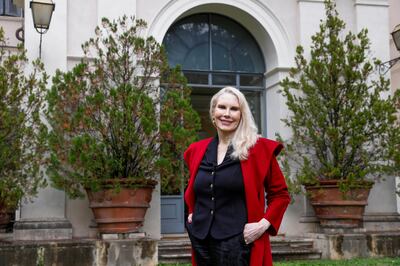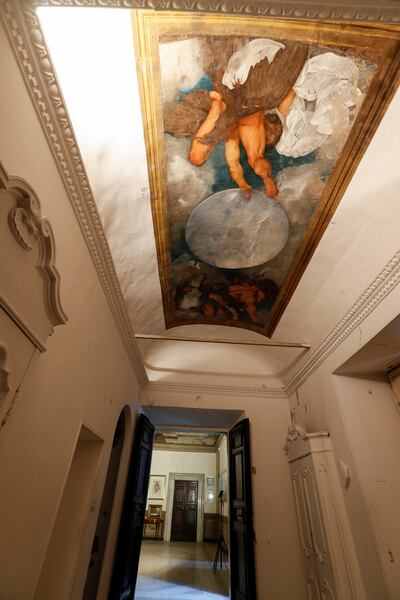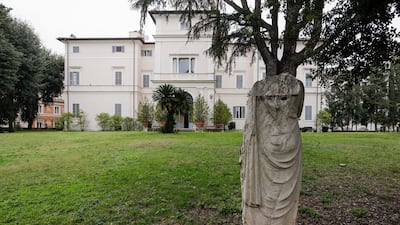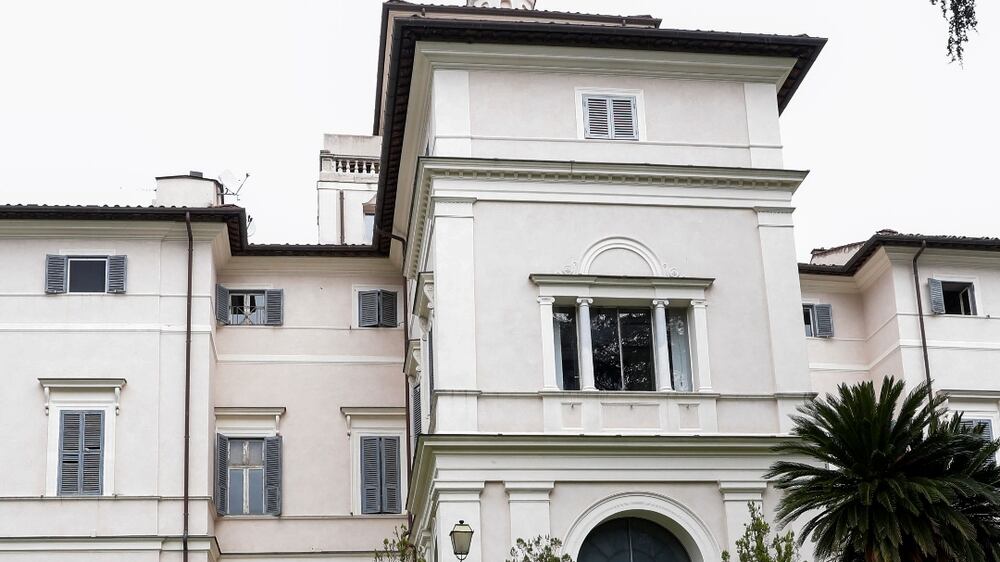The historic Casino di Villa Boncompagni Ludovisi, which has the only ceiling mural ever painted by the Italian Baroque old master Caravaggio, is to be auctioned on January 18 in what some are calling the sale of the century.
Situated on 1.5 acres of land on a hill in the heart of Rome, the aristocratic mansion, known as Villa Aurora, has an estimated value of 471 million euros ($539 million).
Princess Rita Boncompagni Ludovisi, widow of the owner, Prince Nicolo Boncompagni Ludovisi, who died in 2018, has lived in the property for the past 19 years and recounted her initial impressions of the building to The National.
“The first time I entered Villa Aurora, I just fell in love with it,” she says. “It was so beautiful.”
A short walk from the famous Via Veneto, home to some of Rome’s smartest hotels and close to the famed Piazza di Spagna, the ancient Porta Pinciana and Villa Borghese’s majestic park, Villa Aurora is a magnificent refuge from the hustle and bustle of the Italian capital.
“The garden is magical and you do not hear any traffic,” the Texan-born princess says. “It gives that dolce vita feeling that one looks for in Rome.”

Through the centuries, Villa Aurora has welcomed illustrious guests, from the German poet Goethe and Russian composer Tchaikovsky, to the US director and actor Woody Allen and singer-songwriter Madonna. In the words of the American novelist Henry James: “The perfection of the life of ease might surely be led there.”
The auction
After Prince Nicolo Boncompagni Ludovisi died, an inheritance dispute arose between the children from his first marriage and his third wife, Princess Rita, now 72. As a result, the Rome Tribunal decided to put the property up for sale. The auction is due to begin at 3pm CET on January 18 with a minimum opening bid of 353 million euros ($404 million).
An inspection by Rome’s Office of the Ministry of Culture detected the need for about $12.6m-worth of rehabilitation and restoration work which must be carried out at the expense of the buyer.
Built across six levels, the 2,800sq m villa houses unique works of art by not only Caravaggio but also Guercino, Domenichino, Paul Bril and Agostino Tassi.

Of its two terraces, an 18th-century plaque reveals that the one to the north-west was used as an astronomical observatory. “The view from that terrace takes your breath away,” says the princess. “You can see all the beauty of Rome, its monuments and hills. The Pantheon, the Spanish Steps … It’s the most wonderful panoramic view of the capital.”
As the highest spot within the city’s Aurelian walls, the astronomer Galileo was lured to the villa three or four times by late 1622, according to T. Corey Brennan, a professor of classics at the School of Arts and Sciences at Rutgers University, who has spent a great deal of time at the property.
“Galileo was quite friendly with the villa’s founder, Cardinal Ludovico Ludovisi. It is quite a thrill to stand precisely where these two major figures had their conversations about planets and stars,” Prof Brennan tells The National.
The Italian government has a preservation order, giving it the option of buying the house by matching any closing offer at auction. No official statement has been made as yet, but several art experts have called for state intervention.
A petition urging the Ministry of Culture to “defend” Villa Aurora has collected almost 35,000 signatures. The minister of culture has reportedly written to Prime Minister Mario Draghi to determine if and how the government should act.
A glorious past
Originally a hunting lodge, Villa Aurora is all that is left of an estate of more than 30 hectares named Villa Ludovisi, on the site of which the elegant Rione Ludovisi was built after the Unification of Italy.
The Ludovisi is a noble dynasty, comprised of diplomats, patrons of the art and prelates such as Alessandro Ludoviso, who became pope at the beginning of the 17th century.
The estate occupied a part of the Horti Sallustiani, a grand area of the Roman era featuring splendid villas and gardens. During the construction of Villa Ludovisi, a great many busts, statues and Roman artefacts were discovered.
“There are dozens of ancient portrait busts, full-sized statues, relief sculptures and important Roman-era inscriptions on the grounds,” says Prof Brennan. And, the scholar added, there are more to be found.
In 2019, he says, a non-invasive underground survey by Indiana University and Geostudi Astier detected extensive Roman architecture under the villa and its gardens.
“These represent the remains of a former villa of Julius Caesar,” says Prof Brennan. “I am fully confident that excavations would yield spectacular finds.”

A never-ending source of artistic treasures
Villa Aurora was commissioned by Cardinal Del Monte before Cardinal Ludovico Ludovisi, nephew of Pope Gregory XV, bought it in 1621. It was Del Monte who had Caravaggio paint the mythology-inspired ceiling painting Jupiter, Neptune and Pluto at the end of the 16th century.
Guercino subsequently painted the Roman goddess of dawn, Aurora - represented as a young woman on a horse-drawn cart - on the ceiling of a room on the ground floor, from which the building derives its more commonly used name. The artist also completed the painting entitled Fame with Honour and Virtue on a vault on the upper floor.
“In my view, this has to be counted as one of the most intriguing private residences in the world, full of surprises at every turn,” Prof Brennan says.
“The famed Caravaggio ceiling painting was discovered only in 1968; in 2016, we discovered an enormous fresco cycle by the 19th-century artist Pietro Gagliardi behind a false ceiling. In 2019, the photographer Carole Raddato identified an ancient Roman bust as that of Hadrian’s first heir, Lucius Aelius Caesar, one of just several in the world. There is no reason to think that the discoveries will stop.”
Hopes for the future
Unlike other noble residences in the Italian capital that have become museums, Villa Aurora has never been open to the public. Princess Rita has organised guided tours since 2010, and believes that the estate should be opened to the public after the auction at least once a year.
“We’re handing over something that is extremely valuable in the hearts of Italians,” she says. “I spent the best years of my life with Nicolo here at Villa Aurora. I hope that the person who buys it will respect its history and understand what a precious jewel it is.”






